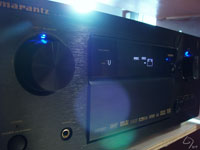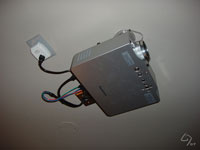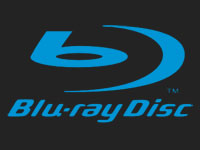| |
The Home Theater. It's
not that this wasn't important before, it actually was, it's
just that because of other happenings in the house certain
budgets needed to be rearranged and the home theater budget
got suspended. So half the stuff was bought and I wasn't about
to let it sit around and get unused. So we bit the bullet and
I finished it off.
The delay worked
to my advantage because Mirantz, the company I wanted to
buy an amp from and whose models were previously too expensive,
 came out with a model the week before in my price range.
It had all the specs and options of the previous model I
had an eye on and more. Put it simply, there’s
a large gap between low-end and hi-end
equipment known as “mid-fi”. Mirantz finally
came out with an amp in that range. This amp has THX Select
2 certification, 7.1 channel output (125 W) and HDMI upconversion,
which means any video I plug in to it will convert to the
HDMI cable I have connected to the projector. HDMI (High
Definition Multimedia Interface) is a single digital cable
that can carry both HD video and surround audio. Any device
that is meant to carry an HD signal (even some that aren’t)
has this interface. came out with a model the week before in my price range.
It had all the specs and options of the previous model I
had an eye on and more. Put it simply, there’s
a large gap between low-end and hi-end
equipment known as “mid-fi”. Mirantz finally
came out with an amp in that range. This amp has THX Select
2 certification, 7.1 channel output (125 W) and HDMI upconversion,
which means any video I plug in to it will convert to the
HDMI cable I have connected to the projector. HDMI (High
Definition Multimedia Interface) is a single digital cable
that can carry both HD video and surround audio. Any device
that is meant to carry an HD signal (even some that aren’t)
has this interface.
For the record,
an “amp”, as I refer to it, is
an amplifier and sound processor. Technically, it’s known
as an “A/V receiver” because it does just that...receives
all the audio and video inputs and outputs them to your speakers
and monitor or TV. All the video is converted to one output
(so only one cable goes to the TV) and the audio is processed,
amplified and separated into all the speakers. For instance
if the broadcast (or recording) is in Dolby Digital surround,
a discreet signal is sent to all 5.1 speakers - front left,
front right, center, rear left, rear right, subwoofer (the “.1”).
In my case, I have a 7.1 system allowing for 2 “rear
center channels” since it’s a long room.
First a little TV tech talk...and this gets complicated so
bear with me. There are 5 basic types of TV technology (and
you thought the remote was complicated enough) - 1) CRT (cathode
ray tube, the big glass tubes that have been around since day
one), 2) LCD (liquid crystal display) flat panel, 3) Plasma
flat panel, 4) rear projection and 5) front projection. Each
of these has their own pluses and minuses.
The CRT’s
are the best in terms of color and clarity, but they are
really heavy and cost prohibitive to make large (36”+...TVs
are measured in diagonal) and they are really being phased
out. Environmentally, they aren't good because they contain
a lot of mercury, which is another reason why companies are
phasing them out.
The flat panels
are taking over. The LCDs are the computer monitors you see
everywhere. Plasmas are the “in thing” in
terms of TVs. Of all the technology, plasma suffers the worst
from burn-in (when a ghost of the image remains on the screen).
That means the CNN ticker, Tivo play bar or video games will
burn into the TV. Not good. It’s also expensive compared
with LCD, and has life of about 5 years. So yes, even though
plasmas have better color and black levels their negative factors
(life, burn-in, price) gives them a big thumbs down in my book...especially
for what I need it for. So plasma is a waste of money if you
ask me.
LCDs are getting much better. Their black levels and respose
time (the two biggest negative factors) are impressive, considering.
Even color. So much so in fact that there are now pro LCD displays
for post production which are replacing the CRTs. So a good
LCD would have a high contrast ratio and fast response (8 ms
or less). LCDs range in size from 20” to
52”,
while plasma ranges from 42” to 65” (I heard they
made a 100” for
mega money).
The latter 2 are
basically the same technology. The projector gun is either
inside the box or out. First using CRT tech in the 80’s and 90’s, the rear projection TVs were
those big ugly TVs that had a very limited viewing angle. The
front projectors were big boxes either on the floor or the
ceiling that had 3 colored lights shining front. Now they use
LCD, DLP (digital light processing) and LCoS (liquid crystal
on silicon) tech. These have significantly reduced the thickness
of the set, and increased the brightness and clarity of the
image. They still have a limited viewing angle, but it’s
far greater than before. They are nothing like their predecessors.
These rear projection TVs are the big screens you see at every
electronics store. The range in size from 37” to 70”.
They are much cheaper than their plasma counterparts. A front
projector needs a screen to project on so the size is based
on the screen you get. The smallest screen I’ve seen
was 73” and they go up from there. Price wise, the sky’s
the limit on the projectors. For an HD projector, they range
from $1 - 50K easy (I’m not kidding).
So to review, I
have an 11’ wall where the TV is going.
The couch is going to be 14' away. CRT’s are phasing
out. LCD flat panels aren’t big enough. Rear projection
could work, but the size I need for that seating distance is
a little expensive. So that leaves front projection. The only
flaw to using a front projector is ambient light on the screen.
Since this will be in the basement with one small window, the
light is controllable so it’s not an issue. Let’s
not forget the coolness factor of having a screen in my home
theater. That being said, there are as many choices for screens
as there are TVs. One of the top (if not the top) screen manufacturer
is Stewart. I found a smoking deal on a screen at the local
Harvey Electronics...a fixed mount (Lexus Deluxe frame) Stewart
Firehawk unused, more than half of the retail price and the
size that I wanted, 92”. That’s a screen that’s
6.75’ wide by 3.75’ tall. Not bad. The Firehawk
is a “gray” screen (as opposed to white) which
is designed to work with LCD and DLP projectors and help filter
out ambient light. So even though the light is controllable,
I plan on playing games on that screen, so the lights need
to be on. The gray of the screen also help produce deeper blacks
that the LCD has trouble with.
 Which leads me to
the projector. I choose a Panasonic HD (1080i) LCD
projector. I got this one because it was the best rated LCD
projector in my price range. As I mentioned, the flaw to
LCD is the deeper blacks that DLP can produce. The flaw to
the DLP is a bigger one, but only on the cheaper models (i.e.
the ones in my price range). The cheaper model DLP use a
color wheel to separate the 3 colors (red, green, blue).
In order to produce an image, the wheel must spin (albeit
very fast) between colors. This causes a rainbow effect that
they say only 1% of the population can see. I can guarantee
I am part of that 1%. I am essentially trained to pick up a
bad frame (1/30 of a sec) while watching real time. They also
say once you see it, you can never not. That was enough for
me to go with LCD. The more expensive DLPs ($8K+) are 3 chip
with no wheel, no it’s not an issue. Which leads me to
the projector. I choose a Panasonic HD (1080i) LCD
projector. I got this one because it was the best rated LCD
projector in my price range. As I mentioned, the flaw to
LCD is the deeper blacks that DLP can produce. The flaw to
the DLP is a bigger one, but only on the cheaper models (i.e.
the ones in my price range). The cheaper model DLP use a
color wheel to separate the 3 colors (red, green, blue).
In order to produce an image, the wheel must spin (albeit
very fast) between colors. This causes a rainbow effect that
they say only 1% of the population can see. I can guarantee
I am part of that 1%. I am essentially trained to pick up a
bad frame (1/30 of a sec) while watching real time. They also
say once you see it, you can never not. That was enough for
me to go with LCD. The more expensive DLPs ($8K+) are 3 chip
with no wheel, no it’s not an issue.
 Got the projector,
screen, and amp. Only 2 things left. First, Tivo. A couple
of months before Tivo finally came out with the Series 3
DVR which was HD. It has a dual tuner (that accepts cable
cards), ethernet port (no more phone dialing), 30 hours of
HD or 300 hours of SD (standard definition) recording. Not
to mention a cool backlit remote. They had a deal where you
can transfer your lifetime membership from an old Tivo to this
one (for a price). This was a sweet deal since they don’t
offer lifetime memberships anymore and my Series 1 is just
sitting around. So I traded in my 32 hour SD Tivo for a 30
hour HD one. Got the projector,
screen, and amp. Only 2 things left. First, Tivo. A couple
of months before Tivo finally came out with the Series 3
DVR which was HD. It has a dual tuner (that accepts cable
cards), ethernet port (no more phone dialing), 30 hours of
HD or 300 hours of SD (standard definition) recording. Not
to mention a cool backlit remote. They had a deal where you
can transfer your lifetime membership from an old Tivo to this
one (for a price). This was a sweet deal since they don’t
offer lifetime memberships anymore and my Series 1 is just
sitting around. So I traded in my 32 hour SD Tivo for a 30
hour HD one.
Tech note. SD vs
HD. SD, or to give you another acronym, is known as NTSC
to us here the US (PAL to those in Europe). Recently, it’s been called simply 480i. The “i” being “interlace”.
There’s also a “p” for progressive, but let’s
not get into that right now. That means there are 480 lines
of vertical resolution in the frame. 720 lines horizontal.
That gives us an aspect ratio of 3:4, or 1:1.33, or just 1.33.
Aspect ratio is important. Ever since TV was getting popular
in the 50’s and 60’s, Hollywood came up with a
new ploy to lure people into the theater - wider screen. Lots
of different aspects came about, but 2 main ones stuck. Known
as “panavision” (2.35 - very wide, like Star Wars
or more recently, The Incredibes) and “academy” (1.85
- everything else you see in the theater). Look on the back
of almost any DVD any you can see these numbers. Since the
SD TV’s didn’t have the ratio to handle to image
of film, they either “pan and scanned” over the
image (bad) or letterboxed it showing the whole image with
black bars on the top and bottom (good).
Now for some reason,
when the engineers came up with HD, they gave it an aspect
of 16:9, or 1.78. Sure it might work mathematically with
SD, but for 90% of the film that’s out there, you
STILL have to letterbox it to see the whole image. Not only
does HD have a different aspect, it has (as its name implies)
a different resolution...a higher one. To complicate things
even further, there are different kinds of HD broadcast. But
let’s just stick with 1080i, or 1080 vertical lines of
resolution with 1920 lines horizontally. That’s more
than 5 times the amount of pixels. The big thing with TV’s
now is 1080p, which while clearer, nothing is broadcast in
it. The only 1080p media is HD-DVD or Blu-Ray.
 Second, Blu-ray
(BRD). I won’t get into the whole HD-DVD
vs Blu-ray war here (despite the fact that as I write this,
Blu-ray is winning ;) ). For the uninitiated, BRD (as is HD-DVD)
is the new high definition media. Just like DVD, it has movies,
games and data storage. It all comes down to data. A regular
DVD holds 4.7 GB of info per side. Double that for dual layer,
etc. BRD holds 25 GB per side. You can see the advantage. I
chose BRD for one simple reason - Playstation. I got the PS3
and it’s a BRD player...one of the best (if not the best)
ones on the market. Yes, you can get them everywhere now, but
I’ve had mine since November and I didn’t have
to wait in line. It’s about the connection. Second, Blu-ray
(BRD). I won’t get into the whole HD-DVD
vs Blu-ray war here (despite the fact that as I write this,
Blu-ray is winning ;) ). For the uninitiated, BRD (as is HD-DVD)
is the new high definition media. Just like DVD, it has movies,
games and data storage. It all comes down to data. A regular
DVD holds 4.7 GB of info per side. Double that for dual layer,
etc. BRD holds 25 GB per side. You can see the advantage. I
chose BRD for one simple reason - Playstation. I got the PS3
and it’s a BRD player...one of the best (if not the best)
ones on the market. Yes, you can get them everywhere now, but
I’ve had mine since November and I didn’t have
to wait in line. It’s about the connection.
So, back to the
set up. First on the list was the projector. It was relatively
simple to install. Knowing where I wanted it to be I installed
the conduit for the video cable and had the electrical line
put in the ceiling during the construction. I had to get
a ceiling mount to hang the projector from. I found a nice
low profile (3”) one from Chief. Anchor
it in, connect the cables and done. The wall in between the
server room (under the stairs) and the main room had a 4 foot
cutout. This is there all the components are. The idea was
I was going to install a shelf for them inside the room, but
for now, I just stacked them on the outside so when the inspector
came, nothing was “under the stairs”.
In the conduit leading
to the front of the room I ran the speaker cable to the 2
fronts and center channel. Since the components are behind
the couch and the projector above it, it would be difficult
to operate any remote. So I picked up what’s known
as an IR blaster that extends the range and direction of
the remote. I put the sensor in the front of the room and
that is connected (via a normal network cable) to a small
box that sends the signal to up to 5 components. I can even
control everything from my desk in the back of the room.
For the lights, I installed a remote IR dimmer so I can control
the light from the comfort of the couch. Ah, technology at
its finest.
I used the same
Boston Acoustics (BA) center channel and floor standing fronts
that I’ve had for years. I got matching
BA wall mounted surrounds for the sides and in-ceiling surrounds
for the rear surrounds. It wasn’t until after the holiday
that I installed the rear surrounds because it was a little
more completed because it involved cutting into the ceiling.
A little messy, but simple to do. The speaker wire was also
easy to pass through because the joists ran in the same direction.
I knew this going in so I didn’t need to bury it in the
ceiling like I did upstairs.
Everything’s now set up and working. I’m ready
to put up the screen. Only one problem...I open the box that
I bought way back in July and it’s the wrong screen.
After a phone call to Harvey, they happily exchanged it for
the one I was supposed to get...which they luckily had in one
of the other stores. So the screen will have to wait. For now,
I’ll just watch TV on the wall. The projectors bright
enough for the color of the wall not to matter...it’s
just the blacks that were affected, and they were a little
red. I got it up for thanksgiving weekend and the premiere
movie was Pixars’ Cars.
After the holiday
I exchanged and installed the screen. It was really easy
to set up, with a little help from Alison, of course...it
was quite large. The metal frame, numbered in each corner,
was put together like any metal picture frame. We then measured
and tested the placement without the screen. Once satisfied,
we removed it, snapped the screen on to it like a boat cover
and the whole thing was hung back on the wall.
The place may still
be a mess, but it's finally set up.
 
prev |1|2|3|4|5|6|7|8|9| next
Back
to the News page |
|